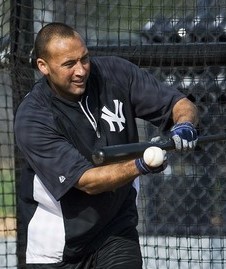
When the Yankees won the World Series in 2009, it was thanks in part to a subtle lineup change that yielded big results. Derek Jeter grounded into a career-worst 24 doubles plays in 2008, so Joe Girardi minimized his rally-killing opportunities by batting him leadoff rather than second. Johnny Damon dropped down a spot to the two-hole, where his unexpected power spike (career-best 24 homers in 2009) was a pleasant surprise. As a result, the Yankees had the best leadoff (132 OPS+) and second best number two hitter (126) production in the game that season.
Damon left as a free agent after that season, but Jeter has remained in the leadoff position ever since. Nick Johnson, Nick Swisher, and Curtis Granderson have occupied the number two spot for the most part during the last two seasons, and Granderson is the obvious choice to do so again in 2012. With Robinson Cano apparently locked in as the number three hitter, Joe Girardi hinted yesterday that Jeter and Granderson could switch lineup spots like Jeter and Damon did three years ago, calling it “a possibility [we] could talk about.”
On the surface, it doesn’t make any sense. Granderson’s power would be minimized atop the lineup while Jeter — who is more of a ground ball hitter now than he was in 2009 — would again be more of a double play threat. The Yankees had the second best offense in the game last season (113 wRC+), and it’s very easy to say don’t fix it if it ain’t broke. This is Spring Training though, and there’s no harm in bouncing ideas around and trying things out on the field in meaningless exhibition games. Flipping Grandy and Jeter is a thought worth entertaining.
For one, Granderson’s power is masking his prototype leadoff hitter skills. Not only is he a stolen base threat (24 last year) and adept a taking the extra base (50% of the time since 2008, well over the 39% league average), but he’s also incredibly patient and makes the pitcher work. Curtis led baseball in pitches per plate appearances last season (4.44), and over the last four years his walk rate has settled in at 11.0% (12.3% in 2011). His inability to hit for a high average means his OBP will be in the .350-.360 range rather than .380+, however.
The typical leadoff man comes to the plate with the bases empty approximately 67% of the time*, which means a whole lot of Granderson’s homers would be solo shots if he bats atop the order regularly. That said, you can make the argument that having Grandy bat “behind” number nine hitter Brett Gardner (.364 OBP last two years) would give him more opportunities to hit with men on base than if he was hitting second behind Jeter (.347 OBP last two years). That’s a simplified look at it, but you get the point. There’s a case to be made.
* I’m willing to bet that number is a bit lower for Yankees leadoff hitters in recent years.

As for Jeter, his propensity for the twin-killing would be somewhat mitigated in the two-hole by Granderson’s extra-base ability. Remember, it’s not just about homers. He hits a ton of doubles (29 last year) and triples (ten) as well, and it’s hard to ground into a double play with the runner on second or third. Jeter’s affinity for a sacrifice bunt — which he does on his own quite often — would be a problem though. Laying down a bunt as the number two hitter means first base will be open when Cano is at the dish, which will lead to plenty of intentional and unintentional intentional walks. Taking the bat out of Robbie’s hands is never a good thing, particularly in the late innings of a close game (when the sac bunt is most effective).
Derek still makes a ton of contact (just 13.3 K% last year), so batting him second behind Gardner and Granderson would give Girardi the option to hit-and-run, a tactic I actually think is underutilized (in the right situation, of course) these days. Batting Jeter second would also split up Granderson and Cano, forcing the opposing manager to choose his spots with his lefty specialist a little more wisely. That’s not necessarily a good thing though, because both Grandy (since getting #cured) and Cano mash left-handed pitchers and you’d like them to face the inferior lefty rather than the superior righty. It would create a bit of a headache for the opposing manager in the late innings, but I think the actual benefit to the Yankees is up for debate.
I don’t think flipping Jeter and Granderson right now makes as much sense as flipping Jeter and Damon back in 2009, but it’s not the craziest idea in the world. Curtis would get a few extra plate appearances throughout the season and the opposing manager will surely make some foolish pitching changes along the way, but the downside is (theoretically) having fewer men on base for Granderson and Jeter’s ground ball double plays. The results could be considerable as we saw three years ago, and if doesn’t work, they could always go back to last year’s arrangement at any time. Consider me intrigued and in favor of giving the switch a try in camp.
Leave a Reply
You must be logged in to post a comment.